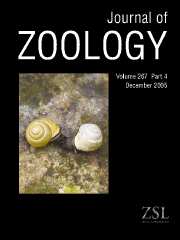Crossref Citations
This article has been cited by the following publications. This list is generated based on data provided by
Crossref.
Chiarello, Adriano G
1999.
Effects of fragmentation of the Atlantic forest on mammal communities in south-eastern Brazil.
Biological Conservation,
Vol. 89,
Issue. 1,
p.
71.
Gilmore, D.P.
Da Costa, C.P.
and
Duarte, D.P.F.
2001.
Sloth biology: an update on their physiological ecology, behavior and role as vectors of arthropods and arboviruses.
Brazilian Journal of Medical and Biological Research,
Vol. 34,
Issue. 1,
p.
9.
Anderson, Robert P.
and
Handley, Jr., Charles O.
2002.
DWARFISM IN INSULAR SLOTHS: BIOGEOGRAPHY, SELECTION, AND EVOLUTIONARY RATE.
Evolution,
Vol. 56,
Issue. 5,
p.
1045.
Anderson, Robert P.
and
Handley, Charles O.
2002.
DWARFISM IN INSULAR SLOTHS: BIOGEOGRAPHY, SELECTION, AND EVOLUTIONARY RATE.
Evolution,
Vol. 56,
Issue. 5,
p.
1045.
CLAUSS, MARCUS
2004.
The potential interplay of posture, digestive anatomy, density of ingesta and gravity in mammalian herbivores: why sloths do not rest upside down.
Mammal Review,
Vol. 34,
Issue. 3,
p.
241.
Chiarello, Adriano G.
Chivers, David J.
Bassi, Clarisse
Maciel, Maria Amélia F.
Moreira, Leandro S.
and
Bazzalo, Mariel
2004.
A translocation experiment for the conservation of maned sloths, Bradypus torquatus (Xenarthra, Bradypodidae).
Biological Conservation,
Vol. 118,
Issue. 4,
p.
421.
Lara‐Ruiz, Paula
and
Chiarello, Adriano Garcia
2005.
Life‐history traits and sexual dimorphism of the Atlantic forest maned sloth Bradypus torquatus (Xenarthra: Bradypodidae).
Journal of Zoology,
Vol. 267,
Issue. 1,
p.
63.
de Moraes-Barros, Nadia
Silva, Juliana A. B.
Miyaki, Cristina Y.
and
Morgante, J. S.
2006.
Comparative Phylogeography of the Atlantic Forest Endemic Sloth (Bradypus torquatus) and the Widespread Three-toed Sloth (Bradypus variegatus) (Bradypodidae, Xenarthra).
Genetica,
Vol. 126,
Issue. 1-2,
p.
189.
Jones, Katherine M. W.
and
Krockenberger, Andrew K.
2007.
Determining the diet of cryptic folivores: an assessment of diet analysis techniques using the green ringtail possum (Pseudochirops archeri) as a case study.
Wildlife Research,
Vol. 34,
Issue. 5,
p.
352.
Urbani, B.
and
Bosque, C.
2007.
Feeding ecology and postural behaviour of the three-toed sloth (Bradypus variegatus flaccidus) in northern Venezuela.
Mammalian Biology,
Vol. 72,
Issue. 6,
p.
321.
Lara-Ruiz, Paula
Chiarello, Adriano G.
and
Santos, Fabrício R.
2008.
Extreme population divergence and conservation implications for the rare endangered Atlantic Forest sloth, Bradypus torquatus (Pilosa: Bradypodidae).
Biological Conservation,
Vol. 141,
Issue. 5,
p.
1332.
Dias, Bernardo B.
Dias dos Santos, Luis Alberto
Lara-Ruiz, Paula
Cassano, Camila Righetto
Pinder, Laurenz
and
Chiarello, Adriano G.
2009.
First observation on mating and reproductive seasonality in maned sloths Bradypus torquatus (Pilosa: Bradypodidae).
Journal of Ethology,
Vol. 27,
Issue. 1,
p.
97.
GREEN, JEREMY L.
2009.
Dental microwear in the orthodentine of the Xenarthra (Mammalia) and its use in reconstructing the palaeodiet of extinct taxa: the case study ofNothrotheriops shastensis(Xenarthra, Tardigrada, Nothrotheriidae).
Zoological Journal of the Linnean Society,
Vol. 156,
Issue. 1,
p.
201.
Hayssen, Virginia
2009.
Bradypus torquatus (Pilosa: Bradypodidae).
Mammalian Species,
Vol. 829,
Issue. ,
p.
1.
Schwarm, Angela
Ortmann, Sylvia
Wolf, Christian
Streich, W. Jürgen
and
Clauss, Marcus
2009.
Passage marker excretion in red kangaroo (Macropus rufus), collared peccary (Pecari tajacu) and colobine monkeys (Colobus angolensis, C. polykomos, Trachypithecus johnii).
Journal of Experimental Zoology Part A: Ecological Genetics and Physiology,
Vol. 311A,
Issue. 9,
p.
647.
de Souto Lima, Rodrigo B.
Oliveira, Pedro A.
and
Chiarello, Adriano G.
2010.
Diet of the thin-spined porcupine (Chaetomys subspinosus), an Atlantic forest endemic threatened with extinction in southeastern Brazil.
Mammalian Biology,
Vol. 75,
Issue. 6,
p.
538.
Giné, Gastón Andrés Fernandez
Duarte, José Maurício Barbanti
and
Faria, Deborah
2010.
Feeding ecology of a selective folivore, the thin-spined porcupine (Chaetomys subspinosus) in the Atlantic forest.
Journal of Mammalogy,
Vol. 91,
Issue. 4,
p.
931.
Superina, Mariella
Plese, Tinka
Moraes-Barros, Nadia
and
Abba, Agustín Manuel
2010.
The 2010 Sloth Red List Assessment.
Edentata,
Vol. 12,
Issue. ,
p.
115.
Heymann, Eckhard W.
Flores Amasifuén, Camilo
Shahuano Tello, Ney
Tirado Herrera, Emérita R.
and
Stojan-Dolar, Mojca
2011.
Disgusting appetite: Two-toed sloths feeding in human latrines.
Mammalian Biology,
Vol. 76,
Issue. 1,
p.
84.
Cassano, Camila Righetto
Kierulff, Maria Cecília Martins
and
Chiarello, Adriano G.
2011.
The cacao agroforests of the Brazilian Atlantic forest as habitat for the endangered maned sloth Bradypus torquatus.
Mammalian Biology,
Vol. 76,
Issue. 3,
p.
243.




